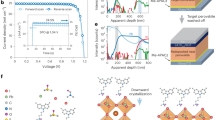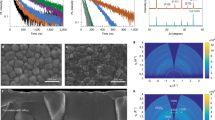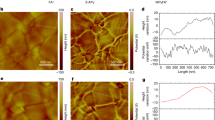Abstract
Inverted perovskite solar cells (PSCs) promise enhanced operating stability compared to their normal-structure counterparts1,2,3. To improve efficiency further, it is crucial to combine effective light management with low interfacial losses4,5. Here we develop a conformal self-assembled monolayer (SAM) as the hole-selective contact on light-managing textured substrates. Molecular dynamics simulations indicate that cluster formation during phosphonic acid adsorption leads to incomplete SAM coverage. We devise a co-adsorbent strategy that disassembles high-order clusters, thus homogenizing the distribution of phosphonic acid molecules, and thereby minimizing interfacial recombination and improving electronic structures. We report a laboratory-measured power conversion efficiency (PCE) of 25.3% and a certified quasi-steady-state PCE of 24.8% for inverted PSCs, with a photocurrent approaching 95% of the Shockley–Queisser maximum. An encapsulated device having a PCE of 24.6% at room temperature retains 95% of its peak performance when stressed at 65 °C and 50% relative humidity following more than 1,000 h of maximum power point tracking under 1 sun illumination. This represents one of the most stable PSCs subjected to accelerated ageing: achieved with a PCE surpassing 24%. The engineering of phosphonic acid adsorption on textured substrates offers a promising avenue for efficient and stable PSCs. It is also anticipated to benefit other optoelectronic devices that require light management.
This is a preview of subscription content, access via your institution
Access options
Access Nature and 54 other Nature Portfolio journals
Get Nature+, our best-value online-access subscription
$29.99 / 30 days
cancel any time
Subscribe to this journal
Receive 51 print issues and online access
$199.00 per year
only $3.90 per issue
Buy this article
- Purchase on Springer Link
- Instant access to full article PDF
Prices may be subject to local taxes which are calculated during checkout




Similar content being viewed by others
Data availability
All data are available in the main text or the supplementary materials. Further data are available from the corresponding author on reasonable request.
Code availability
The codes and postanalysis tools for molecular dynamics simulations are available in the following repository: https://doi.org/10.5281/zenodo.8393081.
References
Park, S. M. et al. Engineering ligand reactivity enables high-temperature operation of stable perovskite solar cells. Science 381, 209–215 (2023).
Zhang, S. et al. Minimizing buried interfacial defects for efficient inverted perovskite solar cells. Science 380, 404–409 (2023).
Jiang, Q. et al. Surface reaction for efficient and stable inverted perovskite solar cells. Nature 611, 278–283 (2022).
Kim, M. et al. Conformal quantum dot–SnO2 layers as electron transporters for efficient perovskite solar cells. Science 375, 302–306 (2022).
Park, J. et al. Controlled growth of perovskite layers with volatile alkylammonium chlorides. Nature 616, 724–730 (2023).
Best Research-Cell Efficiency Chart. NREL www.nrel.gov/pv/cell-efficiency.html (2023).
You, S. et al. Radical polymeric p-doping and grain modulation for stable, efficient perovskite solar modules. Science 379, 288–294 (2023).
Zheng, X. et al. Managing grains and interfaces via ligand anchoring enables 22.3%-efficiency inverted perovskite solar cells. Nat. Energy 5, 131–140 (2020).
Chen, H. et al. Quantum-size-tuned heterostructures enable efficient and stable inverted perovskite solar cells. Nat. Photonics 16, 352–358 (2022).
Li, Z. et al. Organometallic-functionalized interfaces for highly efficient inverted perovskite solar cells. Science 376, 416–420 (2022).
Peng, W. et al. Reducing nonradiative recombination in perovskite solar cells with a porous insulator contact. Science 379, 683–690 (2023).
Camaioni, N. et al. Polymer solar cells with active layer thickness compatible with scalable fabrication processes: a meta‐analysis. Adv. Mater. 35, 2210146 (2023).
Sahli, F. et al. Fully textured monolithic perovskite/silicon tandem solar cells with 25.2% power conversion efficiency. Nat. Mater. 17, 820–826 (2018).
Al-Ashouri, A. et al. Conformal monolayer contacts with lossless interfaces for perovskite single junction and monolithic tandem solar cells. Energy Environ. Sci. 12, 3356–3369 (2019).
Paniagua, S. A. et al. Phosphonic acids for interfacial engineering of transparent conductive oxides. Chem. Rev. 116, 7117–7158 (2016).
Truong, M. A. et al. Tripodal triazatruxene derivative as a face-on oriented hole-collecting monolayer for efficient and stable inverted perovskite solar cells. J. Am. Chem. Soc. 145, 7528–7539 (2023).
Isikgor, F. H. et al. Molecular engineering of contact interfaces for high-performance perovskite solar cells. Nat. Rev. Mater. 8, 89–108 (2022).
Mao, L. et al. Fully textured, production‐line compatible monolithic perovskite/silicon tandem solar cells approaching 29% efficiency. Adv. Mater. 34, e2206193 (2022).
He, R. et al. Improving interface quality for 1-cm2 all-perovskite tandem solar cells. Nature 618, 80–86 (2023).
Phung, N. et al. Enhanced self-assembled monolayer surface coverage by ALD NiO in p-i-n perovskite solar cells. ACS Appl. Mater. Interfaces 14, 2166–2176 (2022).
Farag, A. et al. Evaporated self‐assembled monolayer hole transport layers: lossless interfaces in p‐i‐n perovskite solar cells. Adv. Energy Mater. 13, 2203982 (2023).
Boyd, C. C. et al. Overcoming redox reactions at perovskite-nickel oxide interfaces to boost voltages in perovskite solar cells. Joule 4, 1759–1775 (2020).
Fukano, T. Low-temperature growth of highly crystallized transparent conductive fluorine-doped tin oxide films by intermittent spray pyrolysis deposition. Sol. Energy Mater. Sol. Cells 82, 567–575 (2004).
Neale, N. R., Kopidakis, N., van de Lagemaat, J., Grätzel, M. & Frank, A. J. Effect of a coadsorbent on the performance of dye-sensitized TiO2 solar cells: shielding versus band-edge movement. J. Phys. Chem. B 109, 23183–23189 (2005).
Deng, X. et al. Co‐assembled monolayers as hole‐selective contact for high‐performance inverted perovskite solar cells with optimized recombination loss and long‐term stability. Angew. Chem. Int. Ed. Engl. 61, e202203088 (2022).
Al-Ashouri, A. et al. Wettability improvement of a carbazole-based hole-selective monolayer for reproducible perovskite solar cells. ACS Energy Lett. 8, 898–900 (2023).
Liu, M. et al. Compact hole‐selective self‐assembled monolayers enabled by disassembling micelles in solution for efficient perovskite solar cells. Adv. Mater. 35, 2304415 (2023).
Love, J. C., Estroff, L. A., Kriebel, J. K., Nuzzo, R. G. & Whitesides, G. M. Self-assembled monolayers of thiolates on metals as a form of nanotechnology. Chem. Rev. 105, 1103–1170 (2005).
Paniagua, S. A. et al. Phosphonic acid modification of indium–tin oxide electrodes: combined XPS/UPS/contact angle studies. J. Phys. Chem. C 112, 7809–7817 (2008).
Hotchkiss, P. J., Malicki, M., Giordano, A. J., Armstrong, N. R. & Marder, S. R. Characterization of phosphonic acid binding to zinc oxide. J. Mater. Chem. 21, 3107 (2011).
Nazeeruddin, M. K., Humphry-Baker, R., Liska, P. & Grätzel, M. Investigation of sensitizer adsorption and the influence of protons on current and voltage of a dye-sensitized nanocrystalline TiO2 solar cell. J. Phys. Chem. B 107, 8981–8987 (2003).
Bunker, B. C. et al. The impact of solution agglomeration on the deposition of self-assembled monolayers. Langmuir 16, 7742–7751 (2000).
Dang, H. X. et al. Multi-cation synergy suppresses phase segregation in mixed-halide perovskites. Joule 3, 1746–1764 (2019).
Caprioglio, P. et al. On the relation between the open‐circuit voltage and quasi‐Fermi level splitting in efficient perovskite solar cells. Adv. Energy Mater. 9, 1901631 (2019).
Al-Ashouri, A. et al. Monolithic perovskite/silicon tandem solar cell with >29% efficiency by enhanced hole extraction. Science 370, 1300–1309 (2020).
Li, X. et al. Mapping the energy level alignment at donor/acceptor interfaces in non-fullerene organic solar cells. Nat. Commun. 13, 2046 (2022).
Lami, V. et al. Visualizing the vertical energetic landscape in organic photovoltaics. Joule 3, 2513–2534 (2019).
Sandberg, O. J. et al. On the question of the need for a built‐in potential in perovskite solar cells. Adv. Mater. Interfaces 7, 2000041 (2020).
Moot, T. et al. Temperature coefficients of perovskite photovoltaics for energy yield calculations. ACS Energy Lett. 6, 2038–2047 (2021).
Kühne, T. D. et al. CP2K: an electronic structure and molecular dynamics software package—Quickstep: efficient and accurate electronic structure calculations. J. Chem. Phys. 152, 194103 (2020).
Van Setten, M. J. et al. The PseudoDojo: training and grading a 85 element optimized norm-conserving pseudopotential table. Comput. Phys. Commun. 226, 39–54 (2018).
Grimme, S. Density functional theory with London dispersion corrections. WIREs Comput. Mol. Sci. 1, 211–228 (2011).
Bengtsson, L. Dipole correction for surface supercell calculations. Phys. Rev. B 59, 12301–12304 (1999).
VandeVondele, J. & Hutter, J. Gaussian basis sets for accurate calculations on molecular systems in gas and condensed phases. J. Chem. Phys. 127, 114105 (2007).
Bussi, G., Donadio, D. & Parrinello, M. Canonical sampling through velocity rescaling. J. Chem. Phys. 126, 014101 (2007).
Kryuchkov, N. P., Yurchenko, S. O., Fomin, Y. D., Tsiok, E. N. & Ryzhov, V. N. Complex crystalline structures in a two-dimensional core-softened system. Soft Matter 14, 2152–2162 (2018).
Swope, W. C., Andersen, H. C., Berens, P. H. & Wilson, K. R. A computer simulation method for the calculation of equilibrium constants for the formation of physical clusters of molecules: application to small water clusters. J. Chem. Phys. 76, 637–649 (1982).
Nosé, S. A unified formulation of the constant temperature molecular dynamics methods. J. Chem. Phys. 81, 511–519 (1984).
Hoover, W. G. Canonical Dynamics: Equilibrium Phase-Space Distributions. Phys. Rev. A 31, 1695–1697 (1985).
Bandura, A. V., Sofo, J. O. & Kubicki, J. D. derivation of force field parameters for SnO2–H2O surface systems from plane-wave density functional theory calculations. J. Phys. Chem. B 110, 8386–8397 (2006).
Dodda, L. S., Cabeza de Vaca, I., Tirado-Rives, J. & Jorgensen, W. L. LigParGen web server: an automatic OPLS-AA parameter generator for organic ligands. Nucleic Acids Res. 45, W331–W336 (2017).
Meltzer, C. et al. indentation and self-healing mechanisms of a self-assembled monolayer—a combined experimental and modeling study. J. Am. Chem. Soc. 136, 10718–10727 (2014).
Wang, J., Wolf, R. M., Caldwell, J. W., Kollman, P. A. & Case, D. A. Development and testing of a general Amber force field. J. Comput. Chem. 25, 1157–1174 (2004).
Hockney, R. W. & Eastwood, J. W. Computer Simulation Using Particles (CRC Press, 2021); https://doi.org/10.1201/9780367806934.
Lim, T.-C. Alignment of Buckingham parameters to generalized Lennard-Jones potential functions. Z. Naturforsch. A 64, 200–204 (2009).
Khenkin, M. V. et al. Consensus statement for stability assessment and reporting for perovskite photovoltaics based on ISOS procedures. Nat. Energy 5, 35–49 (2020).
Acknowledgements
This research was made possible by the US Department of the Navy, Office of Naval Research Grant (N00014-20-1-2572). This work was supported in part by Ontario Research Fund-Research Excellence programme (ORF7-Ministry of Research and Innovation, Ontario Research Fund-Research Excellence Round 7). This work was also supported under award number OSR-CRG2020-4350.2. M.W. acknowledges funding from the European Union’s Horizon 2020 Research and Innovation programme under the Marie Skłodowska-Curie grant agreement no. 101026353. T.H., H.R.A. and K.R.G. gratefully acknowledge funding from the National Science Foundation under award no. DMR-2102257. L.X. acknowledges support by National Natural Science Foundation of China (no. 61935016, 52173153) and the Electron Microscopy Laboratory of Peking University for the use of electron microscopes. M.G.K. acknowledges support by the Office of Naval Research under award number N00014-20-1-2725. A.A. acknowledges support by the Office of Naval Research under award number N00014-20-1-2573. P.S. acknowledges the support of the Vanier Canada Graduate Scholarship. This work made use of the NUFAB and Keck-II facilities of Northwestern University’s NUANCE Center, which has received support from the SHyNE Resource (NSF ECCS-2025633), the IIN and Northwestern’s MRSEC programme (NSF DMR-1720139). We thank D. Kopilovic for providing the LED spectrum and J. Gao for assisting with the SEM measurements.
Author information
Authors and Affiliations
Contributions
S.M.P., M.W., M.G. and E.H.S. conceived the idea and proposed the experimental and modelling design. N.L., L.A., V.C. and U.R. carried out the molecular dynamics simulation. S.M.P. fabricated all the devices and conducted the characterization. T.H., H.R.A. and K.R.G. performed XPS, UPS and IPES characterization and data analysis. W.Y. and L.X. carried out the HAADF-STEM measurements. F.T.E., M.W., S.M.Z. and M.G. conducted the photoluminescence and EQE characterization and data analysis. M.W. measured DLS. H.S. conducted cyclic voltammetry measurements and data analysis. D.C. performed UV–visible spectroscopy characterization. Y.Y. and M.G.K. measured TOF-SIMS. K.D. and A.A. performed the GIWAXS measurements. M.V., E.D.J. and D.B.K. helped with the device fabrication and material characterization. P.S. and T.F. performed the KPFM measurements. M.W., S.M.P., N.L., M.G. and E.H.S. co-wrote the manuscript. All authors contributed to data analysis, and read and commented on the manuscript.
Corresponding authors
Ethics declarations
Competing interests
The authors declare no competing interests.
Peer review
Peer review information
Nature thanks Francis Lin and the other, anonymous, reviewer(s) for their contribution to the peer review of this work.
Additional information
Publisher’s note Springer Nature remains neutral with regard to jurisdictional claims in published maps and institutional affiliations.
Supplementary information
Supplementary Information
Supplementary Notes 1–5, Figs. 1–28, Tables 1–3 and refs.
Supplementary Video 1
Classical molecular dynamics simulations of 2PACz adsorption.
Supplementary Video 2
Classical molecular dynamics simulations of 2PACz:3-MPA adsorption.
Supplementary Video 3
AIMD simulations of 2PACz-3-MPA adsorption.
Rights and permissions
Springer Nature or its licensor (e.g. a society or other partner) holds exclusive rights to this article under a publishing agreement with the author(s) or other rightsholder(s); author self-archiving of the accepted manuscript version of this article is solely governed by the terms of such publishing agreement and applicable law.
About this article
Cite this article
Park, S.M., Wei, M., Lempesis, N. et al. Low-loss contacts on textured substrates for inverted perovskite solar cells. Nature 624, 289–294 (2023). https://doi.org/10.1038/s41586-023-06745-7
Received:
Accepted:
Published:
Issue Date:
DOI: https://doi.org/10.1038/s41586-023-06745-7
This article is cited by
-
Highlights of mainstream solar cell efficiencies in 2023
Frontiers in Energy (2024)
-
Multifunctional ytterbium oxide buffer for perovskite solar cells
Nature (2024)
Comments
By submitting a comment you agree to abide by our Terms and Community Guidelines. If you find something abusive or that does not comply with our terms or guidelines please flag it as inappropriate.



